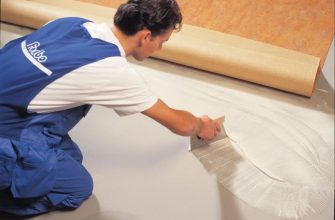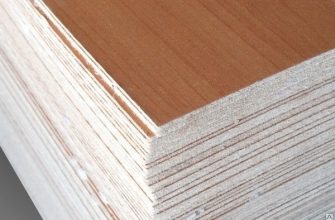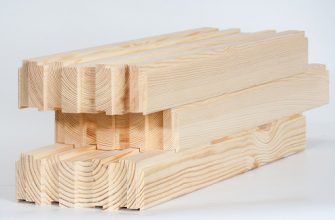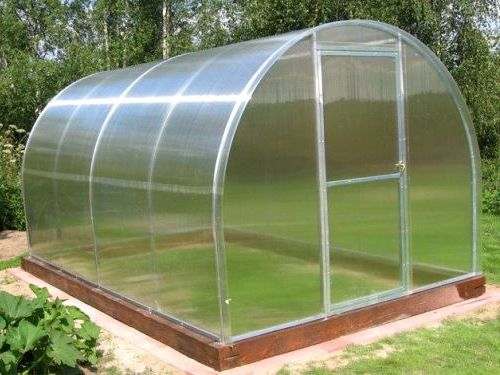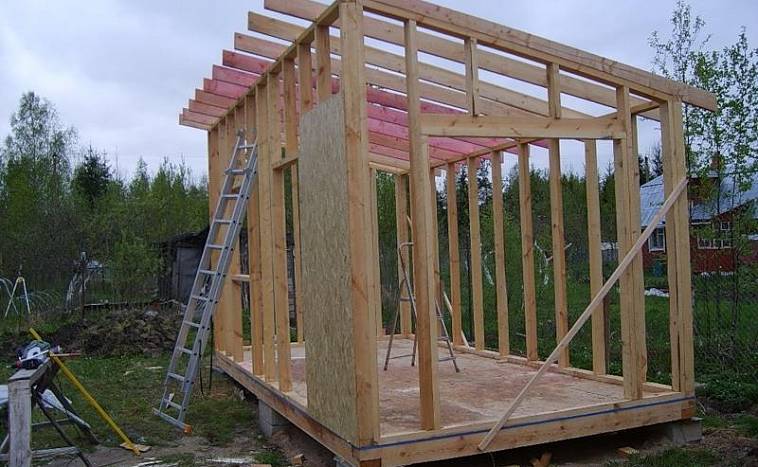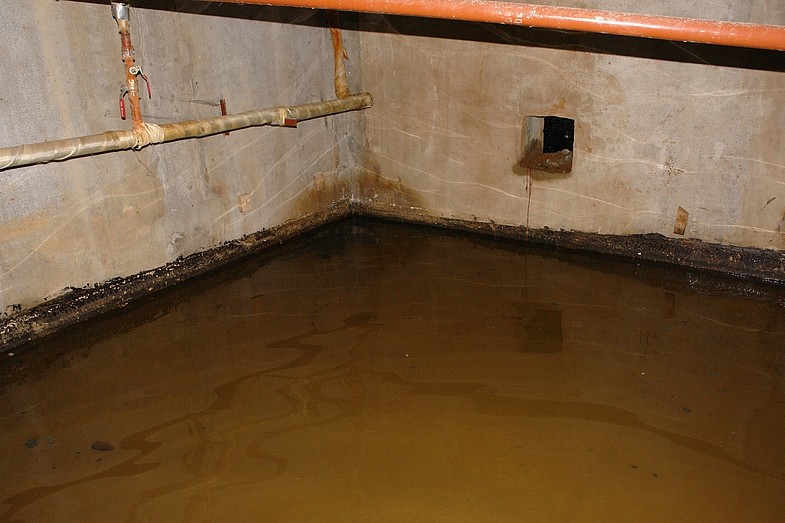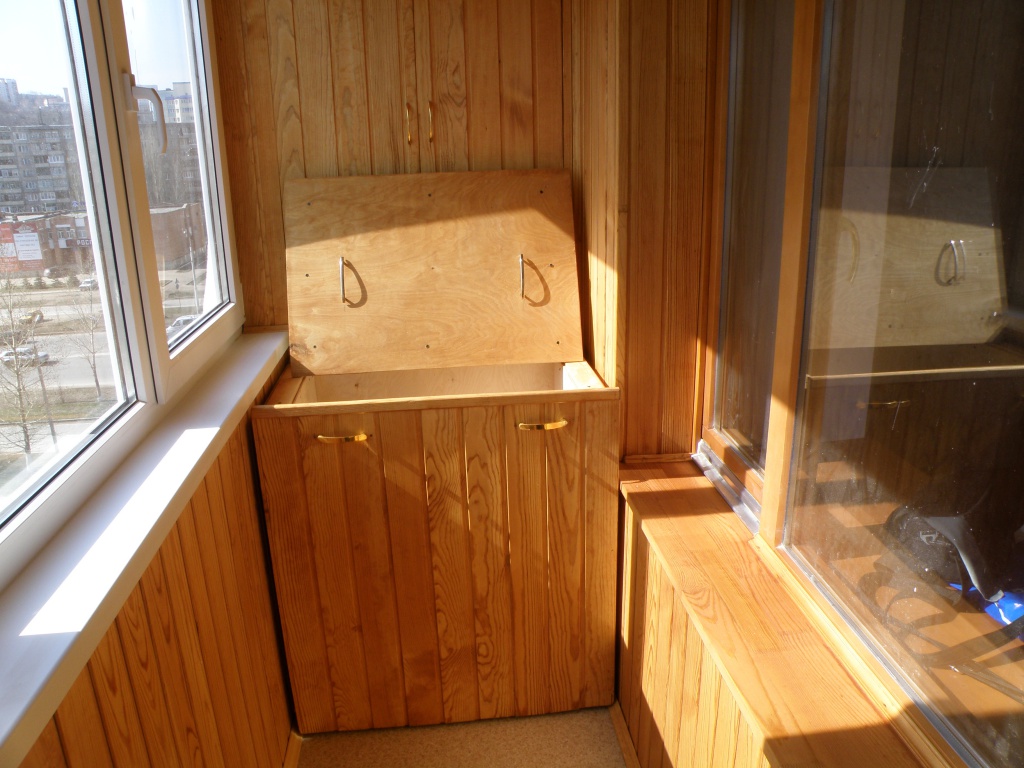The use of tiles in the bathhouse on the floor is no less important than finishing with natural wood. Even in the steam room, where wood is used, the lower part and the basement under the through flooring are tiled. Porcelain stoneware covering is used in the bathroom, recreation room and dressing room, since this allows them to be kept clean. The material resists moisture, temperature extremes and is easy to clean.
- The nuances of laying tiles depending on the type of floor
- How to choose floor tiles for a bath
- Shape and size
- Pros and cons of using floor tiles in a bath
- Tile laying procedure
- Glue and grout
- How to prepare the base and tiles
- Arrangement of water drainage
- Hydro and thermal insulation
- Masonry
- Grout
- Expert advice on laying tiles in a bath
The nuances of laying tiles depending on the type of floor
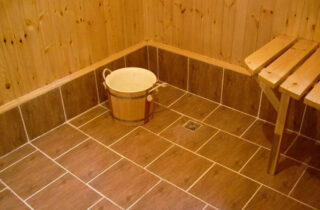
Features of laying floors in a tile bath depend on the type of base. The surface preparation affects the quality of the coating installation. Nuances of working with wood and concrete floors:
- Wood. Fill through holes and knots. Treat the surface with latex or other flowable compound. After drying, lay roofing material or other roll insulator. Fill the screed.
- Concrete. Remove dust from the base. Seal gaps and joints with sealant. After drying, remove excess composition. Apply a 20 cm high liquid primer to the floor.
Before leveling the surface, it is necessary to make a slope towards the drain. For this, guide rails are used.
How to choose floor tiles for a bath
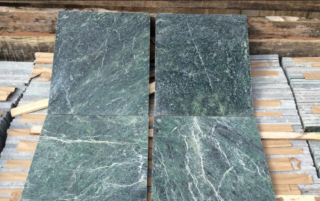
Before laying the floor tiles, it is necessary to select the type of material. Each variety is endowed with a number of features that should be taken into account in the work:
- The clinker type is made from a mixture of several types of clay. Firing is carried out at high temperatures, which gives the material heat resistance, strength to mechanical and chemical influences. The thickness is 9-12 mm. Used for facing the stove.
- The terracotta look has a porous structure, due to which it can withstand sudden changes in temperature. Products are not subject to deformation. For finishing the stove, products with a thickness of 8 mm are used.
- Coil tiles are made from a semi-precious green colored mineral. The material is suitable for cladding a sauna stove. The products belong to the premium segment. The downside is the sensitivity to sudden changes in the regime.
- Talcochlorite slab is made from mountain stone. The main advantage of the material is rapid heating and heat retention. Resistant to prolonged exposure to high temperatures.
- Porcelain stoneware is durable and waterproof. The tiles can be used on sauna floors and in living areas.
- Tiled products are an economical option and are easy to clean. There are no harmful substances in the composition.
After studying the types of tiles in the bath, you can easily choose the best option for the finishing material. When purchasing products, you must additionally purchase glue and grout with a heat and water resistant composition. The quality of the coating depends on these factors.
To increase safety, it is recommended to buy tiles with anti-skid properties, i.e. with a rough surface.
Shape and size
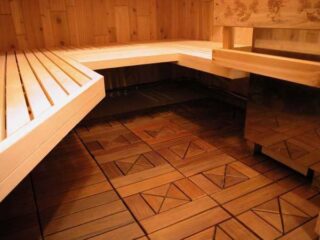
Bath floor tiles are available in different sizes and shapes. This allows for a unique finish. Popular types include square and rectangle. There are also triangular, trapezoidal and shaped products on the market.The owner decides which tile to choose on the floor in the bathhouse based on the financial capabilities and design of the sauna.
The manufacturer indicates the dimensions of the facing material on the package. However, the values may differ from the actual parameters by 2-3 mm. For example, a tile of 200x200 mm in reality has dimensions of 197x197 mm. This point must be taken into account in the calculations.
Pros and cons of using floor tiles in a bath
The qualities of this material - environmental friendliness, moisture resistance and hygiene - speak in favor of choosing tiles for a bath on the floor. The products are made on the basis of clay and mineral fillers that are resistant to temperatures, moisture and condensation. The biological passivity of the facing material resists the formation of mold and mildew. At the same time, the surface of the tile is resistant to chemicals and detergents.
However, the tile also has disadvantages when decorating a sauna:
- in a Russian bath, it is used only in bathrooms;
- experience is required for installation;
- during installation, care must be taken, since the tile breaks easily;
- you need to equip the coating with non-slip products.
It is actual to use the tile under the "warm floor" system. The room will heat up quickly and keep warm for a long time.
Tile laying procedure
The main work is carried out with a tile cutter, notched and ordinary spatulas, as well as a building level. To mix the glue, you need a container and a drill with a special nozzle. Apply the impregnation with a roller. Also purchase crosses that allow you to maintain a uniform thickness of the seams.
Glue and grout
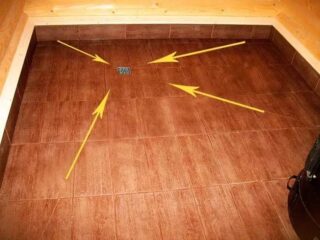
When choosing tile adhesive to be used in the steam room, give preference to elastic compounds. Such products will not deteriorate when heated. In addition, the product is resistant to cooling and expansion. For porcelain stoneware, glue with high adhesion (from 28 kg / cm²) is suitable. This requirement is dictated by the need to fix heavy material.
If the plan provides for a "warm floor" system, the packaging of the composition must be marked accordingly.
The grout is selected according to the permissible width of the distance joint and the type of base - cement or epoxy. The manufacturer indicates the characteristics and properties on the can. The indicator also plays a role in the selection of crosses.
How to prepare the base and tiles
Before laying the tiles in the steam room on the floor, do-it-yourself work on waterproofing the surface. The base is formed with a slope for water drainage. The preparation method is influenced by the type, structure and condition of the surface. A cement-sand screed is suitable for concrete.
Wood is an unstable material, since it is highly susceptible to temperature, moisture and aggressive environmental influences. Such a surface must be carefully prepared for tiling. Treat holes and knots with latex impregnation, prime and fill with a screed.
Arrangement of water drainage
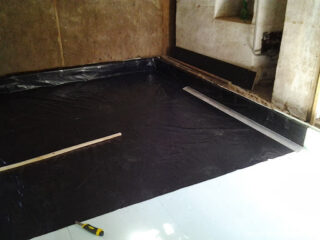
To arrange a drain in the washroom, choose a low place in the bathroom. The material for the gutter must be anti-corrosive. The upper part is selected from heat-resistant compounds so that the surface does not heat up under the influence of temperature. Place the drain funnel in a remote area.
Hydro and thermal insulation
It is allowed to use 2-3 layers of non-combustible polyethylene film as thermal insulation. Mineral wool is also suitable for these purposes. Then the waterproofing works are carried out. The traditional methods are coating and flat methods. The bituminous composition is applied to the surface in several layers. Above is waterproofing and finishing. The method protects the room from moisture.
Masonry
Before laying tiles on the floor in the sauna, carry out a defect in the products - inspect for cracks and chips. Then determine the areas to trim - it is recommended to do this immediately, without being distracted during the work.
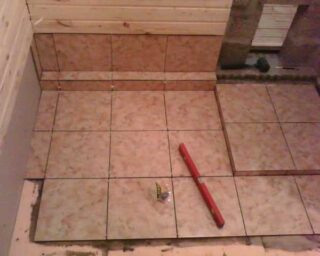
Tiling technology:
- Mark the floor to create a symmetrical pattern and level out excess undercuts. Draw a line perpendicular from the center of the threshold to the opposite wall.
- Lay the first row along the first line, taking into account the seams. Draw the second, aligning along the outer edge of the last fragment. Place the first specimen at the intersection.
- Dissolve the glue according to the instructions on the package and treat the surface slightly more than the area of the elements of the first row. Form the furrows with a notched trowel. If one of the sides of the slab is more than 30 cm, then the composition is additionally applied to the reverse side of the fragment.
- Lay the tiles at the intersection of the lines, keeping in mind 100% coincidence of the edges.
- Smooth out the surface with a rubber mallet. Place crosses in the corners of the product, marking the size of the seam. Lay the first row, leveling the height with a building level or rule. Subsequent flooring work is carried out with the obligatory control of the horizontal line.
For ease of maintenance, install a skirting board at the junction of the tile with the wall. If the tile is adjacent to wood or stone, use moldings in those areas.
Grout
It takes 24 hours to dry the glue - after a day, start grouting. To do this, use a special composition, rubbing the solution with a grater. Stick diagonally to the seam. Do not press hard on the surface. After 15-20 minutes after completing the work, remove the excess with a damp sponge. Wash the floor after 2-3 hours.
If white deposits appear after cleaning the tiles, use special detergents.
Expert advice on laying tiles in a bath
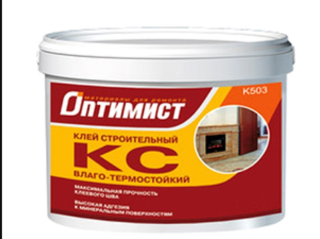
The tiles that will fit under the sauna stove must be placed in water before installation. The residence time is governed by the absence of bubbles on the surface.
It is recommended to use glue with the correct composition for the cladding:
- heat and moisture resistant;
- frost-resistant if the sauna is not heated in winter;
- with high elasticity;
- from a trusted manufacturer.
These requirements are met by polyurethane mixtures with a two-component composition.

